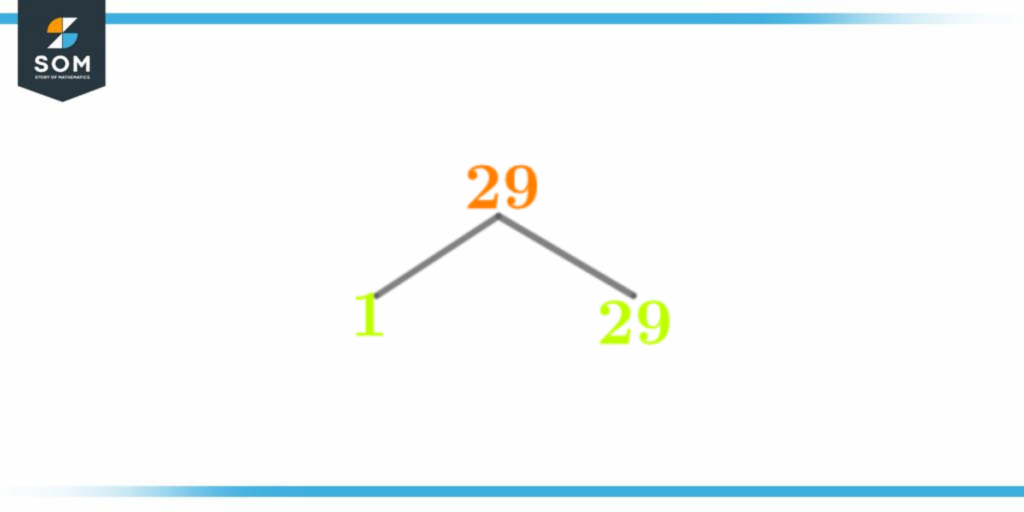JUMP TO TOPIC
Factors of 29: Prime Factorization, Methods, Tree, And Examples
The Factors of 29 are those numbers that give zero as the remainder whenever 29 is divided from such numbers. Since the number 29 is a prime number, it only has two factors.
Figure 1 – All possible Factors of 29
1 x 29 = 29
In this article, we will take a detailed look at the factors of 29. We will also dive into the multiple methods for determining these factors, and we will take a look at some solved examples.What Are the Factors of 29?
The factors of 29 are the numbers 1 and 29. Both these numbers give zero as a remainder when 29 is divided from them. These numbers also yield a whole number quotient due to the division.The number 29 is a prime number, so it has 2 factors, 1 and 29. It also comprises a single factor pair.How To Calculate the Factors of 29?
You can calculate the factors of 29 through the division method. The division method is the most common in mathematics for determining the factors. This method is very accurate and provides precise results.The division method states the number whose factors are to be determined acts as the dividend, and the possible factors act as the divisors. There are two conditions for the said divisor to be qualified as a factor.The first condition is that the said divisor produces zero as the remainder. If the number makes zero as the remainder, then the divisor qualifies to be a factor. The second condition is that apart from the zero remainder, the divisor must also yield a whole number quotient.Keeping these conditions for factors in mind, let’s move on to the division method for determining the factors of 29. Another unique aspect of the number 29 is its prime number. Prime numbers only have two specific factors – one being the smallest factor which is 1, and the other one being the number itself. Let’s take a look at the division of 29:\[ \frac{29}{1} = 29 \]As a whole number quotient, 29 is produced, indicating that the number 1 qualifies as a factor of 29. Now let’s take a look at the division of 29 with this whole number quotient.\[ \frac{29}{29} = 1\]Again, a whole number quotient along with a zero remainder is produced, indicating that the number 29 is also a factor. Hence the factors of 29 are given below:Factors of 29: 1 and 29These factors can be negative as well. The negative factors of 29 are given below:Negative Factors of 29: -1 and -29Factors of 29 by Prime Factorization
Prime factorization is the main technique through which the prime factors for a number are determined. The factors of any number can be both composites as well as prime numbers. The factors which are prime numbers are categorized as prime factors.The number 29 is a prime number, so it does not contain any composite numbers; it only consists of prime factors. These can be determined through prime factorization.In prime factorization, a prime number acts as the divisor for the said number. A whole number quotient is produced as the result of this division, and this quotient acts as the dividend in the next step for division. The prime factorization of the number 29 is shown below:Prime Factorization = 1 x 29
The prime factorization of the number 29 is shown below in figure 1:
Figure 2 – Prime Factorization of 29
Factor Tree of 29
The factor tree is a pictorial representation of the prime factorization method. Through a factor tree, the prime factors of a number are visually represented. At the end branches of the factor tree, prime factors are obtained.For structuring the factor tree of 29, the factor begins with the number 29 as the source. This number extends two branches – one towards a divisor and the other towards a whole number quotient. The factor tree of the number 29 is shown below in figure 2:
Figure 3 – Factor Tree of 29
Factors of 29 in Pairs
The factors of any number can also exist in the form of pairs. These pairs are known as factor pairs. The condition for a factor pair is that the numbers within a pair must give the original number as the product when they are multiplied together. Since the number 29 has 2 factors, these 2 factors can formulate a single factor pair. The factor pair for the number 29 is given below:1 x 29 = 29
Factor Pair of 29 = (1, 29)The factor pairs can also be negative. For a factor pair to be a negative factor, the condition is that both the numbers existing within the pair must have a negative sign so they can yield a positive product when they are multiplied together.The negative factor pairs for 29 are given below:-1 x -29 = 29
Negative Factor Pair of 29 = (-1, -29)Total Number of Factors of 29
The total number of factors of 29 can be determined with the help of the factorization of the number. The factorization of the number 29 is shown below:Factorization of 29 = 1 x 29
To determine the total number of factors of 29, add 1 to the exponents of the factors given in the factorization of 29 and multiply them. The resulting number is the total number of factors of, 29.By adding 1 to the exponents of the factors and multiplying them together, the result is 4, indicating that the number 29 has 4 factors in total – two of them are positive and two are negative.The total factors of 29 are given below:Total Factors of 29 = 1, -1, 29, and -29
Similarly, the factor pairs of 29 are:Total Factor Pairs of 29 = (1, 29) and (-1, -29)
Factors of 29 Solved Examples
To further strengthen your understanding of the factors of 29, let’s considered some solved examples given below involving the factors of 29.Example 1
Determine the sum and the difference of the factors of 29. Also, calculate the product of the two results and determine if it’s a multiple of 2.Solution
To determine the sum and the difference of the factors of 29, let’s first list these factors. The factors of 29 are given below:Factors of 29 = 1 and 29Let’s first calculate the sum of these factors:Sum of factors of 29 = 1 + 29
Sum of factors of 29 = 30
Now, let’s calculate the difference between the factors of 29. The difference is given below:Difference of factors of 29 = 29 – 1
Difference of factors of 29 = 28
Now that we have determined the sum and the difference of the factors of 29 let’s calculate the product of the two results obtained. Calculating their product:Product = Sum of factors of 29 x Difference of factors of 29
Product = 30 x 28
Product = 840
As the number 840 is an even number, that indicates that the number 840 is a multiple of 2. This is shown below:2 x 420 = 840
Hence, the number 840 is a multiple of the number 2.Example 2
List down the factors of 29 and determine their average.Solution
For calculating the average of the factors of 29, let’s first list these factors down. The factors of 29 are given below:Factors of 29 = 1 and 29Now, let’s calculate their average. The formula for calculating the average is given below:\[ Average = \frac{\text{Sum of factors of 29}}{\text{Total number of factors of 29}} \]\[ Average = \frac{ 1+29}{2} \]\[ Average = \frac{30}{2} \]Average = 15
So the average of the factors of 29 is calculated to be 15. All images/mathematical drawings are created with GeoGebra.